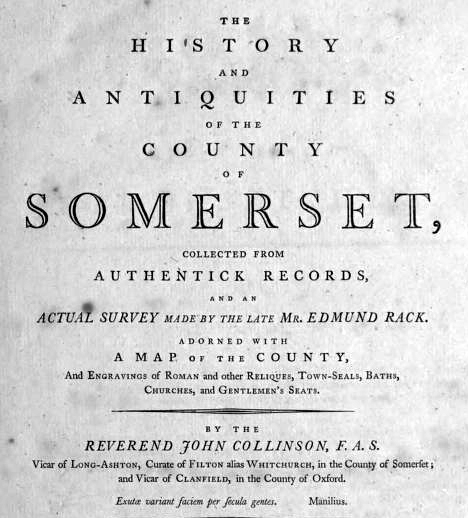Collinson’s History of Somerset is very important for the study of Bridgwater Castle, but unfortunately not for the right reasons. He made a number of errors which have hence been repeated and now distort the general understanding of the castle.

The castle, to which the [town] arms bear allusion, stands on the west side of the quay, and was anciently a very large and noble structure, the government whereof was always vested in persons of the highest eminence and distinction. It was built about the year 1202, and having experienced a series of vicissitudes, such as generally befall important holds, was at length, in the year 1645 nearly levelled to the ground in the parliamentary confusions.
Bridgwater Castle was not demolished in 1645. Collinson confuses accounts of the defences built around the town during the Civil War with the castle itself, it seems to be from Joshua Sprigg’s contemporary description of the storm of the town. The subsequent levelling of these defences did not entail any demolition to what was left of the castle.
It had forty guns mounted on the walls, which were in most parts fifteen feet thick, and all the fortifications were regular and strong.
The forty guns were those which defended the town as a whole during the Civil Wars, not the castle. This is another detail from Sprigg. It is questionable that any guns would have been mounted on the walls of the castle. Although the assertion that the walls were fifteen feet thick, this seems only to be true of the wall along the river front, which needed to be substantial to stop it slipping into the river. This wall was wide at the bottom, but tapered further up. The other walls would have been tall, but not as thick, which partly explains why they have not survived to this day.
The moat was thirty feet wide, of great depth, and every tide filled with water.
Although the moat was wide and deep, it was not filled with water on each tide. The town ditch in Eastover was, which Collinson has confused it with, again a detail from Sprigg. The moat was fed by springs and water was contained with weirs. The height of the ground around the castle is far too high for even the Parrett to reach, especially the further away from the river one goes.
This assault put nearly a finishing period to the castle, of which now only a few parts remain; as the water port and some ruins of the lodge. The Ballium is at present used for a deal yard. Henry Harvey, proprietor of it in 1638, converted the old gatehouse into a mansion of the form of a Roman B.
The water port is what is now called the Watergate and the Ballium was what is now King Square. The ruins of the lodge is the building recorded by John Chubb and is the remains of the mansion which had a ground plan in the shape of a B. This was almost certainly the work of Henry Harvey as Collinson, but the date for the conversion was probably closer to 1630. 1638 was the year Harvey built a house by the town bridge, which Collinson has confused with the mansion. That Collinson describes that this building was converted from an old gatehouse is interesting. The shape of the building would support this assertion and on this there is no reason to doubt Collinson.
Collison’s history in full can be found here,
